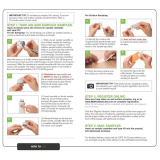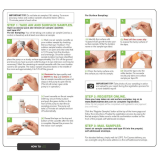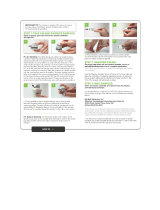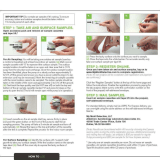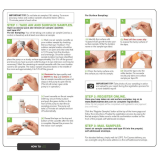Page is loading ...

Air Sampling
Handbook

Contents
1. Introduction & Aims ...............................................................................1
2. Personal Air Sampling Dust and Fumes ..............................................2
2.1 Sampling train for dusts ....................................................................2
2.2 Types of heads ................................................................................. 4
• Total Inhalable Sampling Heads
• I.O.M. Type Head & Cassette (P109009A & P109010)
• Conical Inhalable Sampler
• Total Inhalable Sampler 7/Hole MMMF Head
• Respirable Sampling Heads
• Higgins-Dewell Sampling Head
• Dorr Oliver Sampling Head
• Aluminium Cyclone for Respirable Dust
Other Sampling Heads
• Lead Sampling Head
• Open Faced Filters
• Solder Fume Sampling Head
• Asbestos Sampling Head
2.3 Filters and Filter Media ...................................................................12
2.4 Types of cassettes ..........................................................................14
• Blank Sampling Cassette Housings
• Pre-Loaded Cassette Housings
• Pre-Weighed Filter Cassettes
• Match Weighed Cassettes
2.5 UseofPUFltersinpersonalsampling ......................................... 18
3. Personal Air Sampling for Gases and Vapours .................................20
3.1 Low Flow Adaptors and Constant Pressure Mode ......................... 21
3.2 Types of Sorbent Tube ................................................................... 23
3.3 Bubblers and Impingers .................................................................24
3.4 Grab Sampling ................................................................................25
3.5 Calibration ....................................................................................... 26
• Field Calibration
• Primary Calibration
3.6 Your Personal Sampling Pump ....................................................... 28
• Batteries
• Pulsation
• Back Pressure Capability
• Constant Pressure Control
• Size, Weight, Wearability and Motion Sensing
• Connectivity and Data Download
• Intrinsic Safety
3.7 Area Sampling and Environmental Sampling .................................32
• Area Sampling
• The Microdust Pro
• Dust Detective
• Dust Guardian
4. Glossary ................................................................................................34

1
1. Introduction
Introduction and Aims
Many industrial and construction sites have the potential
to expose their employees to harmful dust, vapours and
gases.Inhalationisusuallythemostsignicantrouteof
entry into the body and so monitoring the air they inhale
is vitally important. This handbook aims to give an
introduction to air sampling applications and the equipment
required.
The information contained in this handbook refers only to
equipment that Casella supplies and it is not intended to
adviseorinuenceadoptedsamplingstrategy.Selection
ofthecorrectsamplingheadandowrateshouldbe
dictated by local legislation and guidelines, typically issued
by the relevant regional health and safety organisations.
As an additional resource to this handbook,
Airsamplingsolutions.com is a dedicated website with
a searchable database of hazardous materials. This
has links to HSE and NIOSH methods, sampling kits,
accessories and consumables, along with exposure limits
andowratesettings.
HB4071-02

2. Personal Air Sampling Dust and Fumes
2.1 Sampling Train For Dusts and Fumes
In general terms a known volume of air is drawn using a sampling
pump through a suitable sampling medium. For particulates and
fumesthiswouldbealterpaper.Anappropriatesamplingtrainfor
personal monitoring would look like this with the sampler mounted
in the breathing zone:
Apex2 pump
A personal sampling pump would be connected to a sampling
headcontainingasuitablelterviaalengthoftubing.Thepumpis
normally worn on the belt but it can be mounted on the back or the
chest in a suitable harness. The sampling head, however, must be
in the breathing zone for a valid sample.
Dust is particles of solid material around 1µm to 100µm diameter.
Larger particles are too heavy to remain airborne. Fumes are solid
particles formed by condensation from a gas and the particle size is
typically <1µm.
2

3
Dust can further be categorized into size fractions: Total Inhalable
Dust, Respirable Dust and Thoracic dust. Below is a graph of the
ACGIH / CEN / ISO sampling convention where the red line indictes
a 50% (D50) cut point.
In real terms, Total Inhalable Dust is the fraction of particulates (up
to 100µm) that enters the nose and mouth during breathing and can
be deposited anywhere in the respiratory tract. Respirable dust,
however, is smaller (up to 10µm) and can penetrate into the deep
lung where gas exchange takes place. It is this fraction which is
more harmful because these dust particles cannot be expelled by
the body’s own defences. It should be noted that if you sample for
Total Inhalable Dust, it will also contain those smaller fractions.
Different sampling heads are needed to measure the different
fractions,seesection2.2.Apre-weighedlterisusedandavolume
ofairisdrawnthroughthelterusingapersonalsamplingpump
atasetowrateoveraknownamountoftime.Itisimportantto
calibratetheowratebeforeandcheckagainaftersampling.The
lterisre-weighedpostsamplingandtheweightgainnoted.The
calculation of concentration is as follows and is expressed in mg/m
3
.
CALCULATION OF CONCENTRATION
Concentration (mg/m
3
) = Weight Gain (mg) x 1000
Flow rate (l/min) x time (min)

4
2.2 Types of Personal Sampling Heads
Total Inhalable Sampling Heads
Total inhalable sampling heads collect all fractions of particulates
(up to 100µm) which enter the nose and mouth during breathing,
i.e. everything that is available in the air to be inhaled. It is possible
tosizeselectusingsomeoftheheadswiththeuseofPUFlters
(see section 2.5) but if you are only interested in the Respirable
Fraction it would be preferable to use a cyclone head.
IOM-type Head & Cassette (P109009A & P109010)
The IOM-type inhalable dust sampler is the most
commonly used head for Total Inhalable Dust sampling.
Developed by the Institute of Occupational Medicine,
this type of sampler is used with a cassette
ensuring that no sample is lost on the walls
of the sampler. The whole cassette including
thelterpaperispre-andpost-weighed
ensuring that the entire sample is accounted for.
The diagram below shows the component parts:
TheIOM-typeheadusesa25mmlterhousedinacassettewhichis
pre-weighedasasingleunit.Itisoperatedata2.0l/minowrate.
It has the advantage of being able to sample different size fractions
simultaneouslythroughtheuseofPUFlters.SeeSection2.5for
descriptionofitsusewithPUFlters.
The IOM-Type Head

5
Conical Inhalable Sampler (P118200)
The Conical Inhalable Sampler (CIS.)
is primarily used when there is a
need to sample a high concentration
ofparticulate.Alargersizeoflteris
therefore used (37mm). The cone is
designed to spread the sampled dust
evenlyoverthelterwhichishousedin
a cassette. The cassette, complete with
37mmlterispre-weighedasasingleunit.
TheCIS.headisoperatedataowrateof
3.5l/min.
Conical Inhalable Sampler
Like the IOM-type head, the CIS head has the advantage of being
able to sample different size fractions simultaneously through the
useofPUFlters.SeeSection2.5fordescriptionofitsusewith
PUFlters.

Total Inhalable Sampler 7/Hole MMMF Head
This sampler can also be used for total
inhalable samples and is known as the
Seven Hole Head (7HH) or head for Man
Made Mineral Fibres (M.M.M.F.). Like the
IOM-typehead,theowsettingforthisparticular
samplingheadis2l/minandusesa25mmlter.
Thetypeoflterusedwouldbedependentupon
thenalanalysis,whetherGFAforgravimetricor
membraneltersforfurtheranalysisofthesample.
(Please see section 2.3)
Respirable Sampling Heads
Respirable dust is usually collected using a cyclone head. The
shape of the head rapidly circulates the air drawn through and the
larger particles are forced to the outside of the air stream where
they drop into a grit pot. These are discarded. The smaller particles
aredepositedontothelterforanalysis.Sizeselectivityofthehead
isdependentontheshapeofthecycloneandalsotheowrate
soitisvitalthattheowratesetremainssteadythroughoutthe
sampling so as not to introduce errors. They are designed to meet
the ACGIH / CEN / ISO size-selection curve with a 50% cut point at
4.0µm.
6
Total Inhalable 7 Hole Head

7
Higgins-Dewell Sampling Head (11600B)
The Higgins-Dewell (HD) cyclone is most
commonly used in Europe and is usually
made from conductive plastic, although
metal versions are available.
The diagram below shows the
component parts.
Higgins-Dewell Cyclone Head
Thecycloneheadusesa25mmltercassettewhichcanwe
weighed complete. 37mm heads are also available. The cyclone
operates at 2.2l/min.

Dorr Oliver Sampling Head
(P101010)
The Dorr Oliver Sampling Head
is used in conjunction with a
37mm 3 piece open face
ltercassette.Thisismore
commonly used in the USA.
The cyclone operates
at 1.7l/min.
Aluminium Cyclone for Respirable Dust
The aluminium cyclone removes electrostatic effects and is small
and lightweight. It is available in both 25mm and 37mm versions.
It is used in conjunction with an open faced, 3-piece cassette
withlter.Itisdesignedtoprovideasharpsizeselectionatow
rates of 2.5L/min (50% cut 4µm) and 3.8l/min (50% cut 3.5µm)
8
Shown in cyclone
holder with 37mm
2-piece cassette

9
Other Sampling Heads(B8221/Z)
Lead Sampling Head
This design was developed to sample for radioactive particles
(UKAEA)andlead.Thisheadusesa25mmlterat2l/min.
Open Faced Filters (P109104 & B7632/Z)
Theopenfacedlterholderisavailablein25mmor37mmversions.
Open Faced Filter

10
Solder Fume Sampling Head (P109049)
Solder Fume Sampling Head
This head is designed for sampling the fumes
generated by the rosin-cored solder used
in the electrical and electronic industries.
Use13mmltersataowrateof
1l/min for long term sampling or
2l/min for
short term sampling.

11
Asbestos Sampling Head
Airborneasbestosbresaresampled,likegeneraldustsampling,
bydrawingameasuredvolumeofairthroughamembranelter.
However,ratherthangravimetricanalysis,thebresarecounted.
Thisisdonebymountingthelterontoamicroscopeslidethen
disolving the membrane with solvents. Fibres on a measured area
oflterarecountedusingphasecontrastmicroscopy(PCM)and
thenumberconcentrationofbresintheairiscalculated.
Casellaoffersspecicsampling
accessories for the analysis
ofasbestosbres:Anopen
facedlterholderttedwithan
electrically conducting cylindrical
cowl is required along with MCE
lterswithaprintedgrid.MCE
lters(amixtureofcellulose
acetate and cellulose nitrate)
are recommended for asbestos
sampling as they are readily
rendered transparent. Pre-loaded
asbestos cassettes are also
available in pore sizes of 0.8µm
and 0.45µm for ease of use.
Asbestos Sampling Head

12
2.3 Filters and Filter Media
Filters are available in a number of different materials; the most
commontypeisglassbre,wheregravimetricweighingisthe
only analysis. If further analysis is required or the hazard being
samplediscorrosiveorifthereisinterferencewithglassbrethen
other types are recommended, e.g. mixed cellulose ester (MCE),
PVC, PTFE, Polycarbonate, Quartz, and Silver. Please check your
standardisedmethodforthecorrectltertouse.Filtersarealso
available pre-weighed or pre-loaded into cassettes.
Main Properties Air Sampling
Applications
Glass Fibre Theselowcostlters
are commonly referred
toasdepthlters.They
are ideal for general
gravimetric air sampling
and analysis. Suitable
when no other analysis
than weighing is required.
Binder and additive free.
Available unweighed and
pre-weighed.
Fastestowrate
High load capacity,
No electrostatic
problems,
Low pressure drop,
Up to 500
o
C Range,
Inert Composition,
Sub micron level,
retention
General
Gravimetric,
Isocyanates,
Ethylene Glycol,
Air Quality
Fractions
MCE Developed from a mixture
of cellulose acetate and
cellulose nitrate, MCE
ltersaresuitableforair
monitoring where further
analysis other than
gravimetric is required.
They are available in
a range of pore sizes.
They are also available in
griddedversionsforbre
counting.
Dissolves completely,
Readily rendered
transparentforbre
counting,
No moisture issues
Metal dust
analysis,
Asbestos and
man-made
bres,
Air quality
PVC Highqualityltersfor
measuring dust, silica and
chromium. They have a
low tare weight so suitable
for lower sample levels
and have gravimetric
stability. Low ash levels
means interference free
silica determinations
Low tare weight,
Silica free and low ash,
Non-oxidizing surface,
Low moisture pick-up
Gravimetric
analysis,
Hexavalent
Chromium,
Silica

13
Main Properties Air Sampling
Applications
PTFE High quality, chemically
resistantlterssuitablefor
aggressive environments.
Suitable for highly
sensitive, interference free
determinations. Low tare
weight means gravimetric
stability and suitable for use
with lower sample levels.
Hydrophobic,
Chemically inert,
Suitable for
aggressive
environments
Alkaline dusts,
PAH’s,
Pesticides,
Isocyanates,
Ambient air
quality
Polycarbonate Theseltershaveasmooth
glass-like surface with
precise pore size and
distributionforspecic
ltrationandseparation.
Available in a range of
pore sizes. They are
optically transparent and
non-staining which means
they are ideal for sample
observations
Smooth surface for
microscopy,
Precise pore size
and distribution,
Chemically and
Biologically inert,
Strong,
Optically transparent
& non-staining
Asbestos
bres,
Scanning
electron
microscopy
applications
Quartz Quartzltersareheat
treated for improved
purity allowing trace level
analysis. They are heat
resistant and suitable for
use in stacks or for diesel
emissions and are acid
resistant. They have a
highowrate.Binderand
additive free.
High purity for trace
level analysis,
Temperature
resistantto300˚C,
Autoclavable,
Highltrationrate
High
temperature
applications,
Stack
sampling,
Diesel
particulates,
Acidic gases
Silver Made from high purity
silver,theselterscanbe
cleaned and re-used. They
have a smooth surface
for particle capture and
easy observation. They
are available in different
pore sizes
99.97% pure silver,
High temperature
resistance,
High chemical
resistance,
Uniform porosity and
thickness
Bromine,
Asbestos by
TEM,
Silica by X-ray
diffraction

14
2.4 Types of Cassette
Heads like the I.O.M. type head and the Higgins Dewell cyclone
have a cassette included in their design. For other heads like the
Dorr Oliver Cyclone, the hygienist would opt for a separate cassette
totintothesampler.
Sampling cassettes are convenient as they, not only protect the
lterduringsamplingbutaregoodfortransportation.Generally
there are two different types: A 2-piece and a 3-piece design.
A 2-piece design would be used for ‘closed face’ sampling.
A 2-piece
Cassette Conguration
‘Closed face’ sampling refers to sampling where only the plugs are
removedandairisdrawnthroughthelter.A2-piececassetteis
better for this because the cassette itself exerts electrostatic forces
which attract the contaminants to the walls of the cassette and a
2-piece cassette has less surface area for contaminants to cling to
insteadofbeingcaughtonthelter.
The3-piececassetteoffersmoreprotectiontothelterbyhaving
and extra ring which offers protection for ‘open faced’ sampling
where the inlet piece as well as the plug are removed for sampling.
The 3-piece cassette is also used in conjunction with cyclones.
A 3-piece
Cassette Conguration

15
Please take care to attach your cassette the correct way. The
‘wagon wheel’ design at the base is the outlet face, otherwise your
sample will be deposited on the support pad.
Casella offers a range of different cassette options. Here are the
different types and when you might use them:
Blank Sampling Cassette Housings
These are available in either a 2-piece or a 3-piece cassette in
25mm or 37mm. Blank cassettes enable you load your own pre-
weighedlter,eitherastandardGFAlterforgravimetricdataora
morespecialistltermediumforfurtheranalysis.
The most common material for these cassettes is styrene which
is clear and provides excellent visibility. We also offer an opaque
version if your sample is likely to be light sensitive. Choose a
polypropylene version if you need protection against solvents
or choose a carbon loaded polycarbonate cassette to minimise
electrostatic interference.
Filtersupportscanbeusedbehindltermembranestosupport
themfromcollapsingwhilestillallowingfreeairowthroughthem.
Available in 3 different styles:
■Cellulosepadsaremadeupof100%purecelluloseandthemost
commonsupportusedinltercassettes.
■Porousplasticsupportsworkwellwhensamplingchemicalsthat
are not compatible with cellulose.
■Stainlesssteelgridscanbeusedinawiderangeoflterholders
and can easily be cleaned and re-used.

16
Pre-Loaded Cassette Housings
Thesearepreloadedwithachoiceofltermediae.g.PVC,MCE
or PTFE and you would use them when there is chemical analysis
orextractiontobedoneonthelterpostsampling.Thatmeans
that you can just remove the plugs and
start sampling. If it is just a gravimetric
result that you need, choose pre-
weighed or match-weighed cassettes.
They are available as 25mm or 37mm
cassetteswithyourchoiceoflter
media. Please consult your standard
method for the media you need.
Pre-Loaded Cassettes
Pre-Weighed Filter Cassettes
Pre-weighedltercassettesarepre-loadedwithaPVCmembrane
at a testing laboratory and then, after sampling, returned to the
same laboratory for re-weighing. The process of weighing is
included in the price of these cassettes. To comply with directives
it is vital that you return the cassettes to the SAME laboratory as
the ‘tare’ and the ‘secondary weight’ must be performed on the
same microbalance under the same environmental conditions.
Environmentalconditionshaveasignicanteffectonweightand
becausethelterisweighedto0.01mg,thevariationandcalibration
betweendifferentmicrobalancesalsobecomesasignicantfactor.
Each cassette is labelled with a weight and serial number for
identicationpurposes.

Match Weighed Cassettes
These offer the convenience of the pre-weighed
ltersinthatthelterispre-loadedandyoucan
just begin sampling. You do not need to return
them to the same laboratory to comply.
Match Weighed Cassette
Eachcassettecontainstwolterswhicharematchedinweight
withinatolerance(50µgfortheMCEltersand20µgforthePVC
lters).Fromthebelowdiagramyoucanseethatairisdrawnin
throughtheinletanddepositedonthetestlter.Thereisasecond
lterunderneathwhichactsasablank.Aftersampling,bothlters
are equilibrated and re-weighed and the difference in weight is the
amount of contaminant.
Inre-weighing,itisquitepossiblethatthebottom‘control’ltermay
weighmorethanthetestlterbutwithinthetolerancestated.Ifthis
is the case, it may be that no sample has been taken or that the
inlet/outlet of the cassette has been switched.
17

18
2.5 Use of PUF Filters for Size Fraction
Selection in Personal Air Sampling
It should be noted that there are different conventions for size
selection for Occupational Hygiene and for the Environment.
While Occupational and Environmental agencies both measure
particulatesinair,theyhavedifferentdenitionsandmethodologies
for assessing the particulates.
Occupational Hygienists sample for ‘Total Inhalable’, ‘Thoracic’
and ‘Respirable’ fractions whereas for Environmental sampling, we
would refer to PM10 and PM2.5 fractions. In general terms PM10
compares closely with the ‘Thoracic Fraction’ and PM2.5 equates
with the ‘High Risk Respirable’ fraction. However the sampling
conventions, whilst similar, are not identical.
Probability or aerosol penetration as a function of aerodynamic
diameter, internationally agreed by CEN/ISO/ACGHI
/

